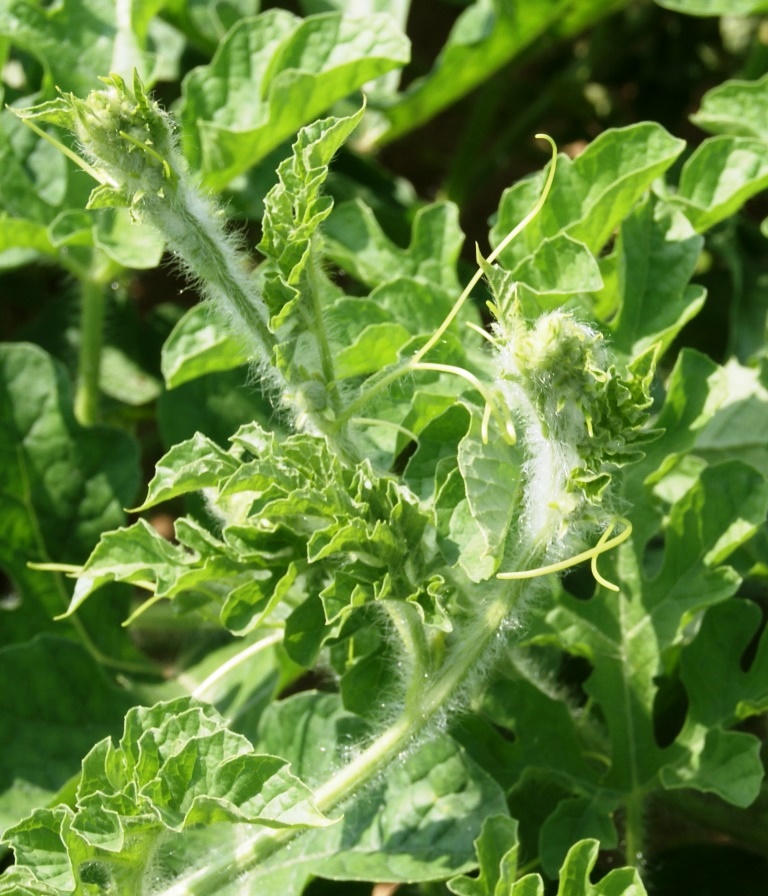UF/IFAS Extension Suwannee Valley Weekly Watermelon Crop Update – April 5, 2021
–
Summarized by Bob Hochmuth with input from Suwannee Valley Extension Agents: Mark Warren, Tyler Pittman, Tatiana Sanchez, Luke Harlow, Jay Capasso, Sylvia Wills, Dan Fenneman, Keith Wynn, Danielle Sprague, Kevin Athearn, and Charles Barrett.
–
Frosty Review
–
Too close for comfort! Well, it appears that we escaped a near total disaster, but not unaffected for sure. Temperatures quoted on early Saturday morning in the region ranged from 32-37 degrees F, all a bit lower than forecasted. Bob’s thermometers at downtown Columbia City read 32 and 33 respectively and the lawn was covered with a solid (crunchy) frost. I think we all looked at daybreak Saturday with a lot of concern. Mark Warren and Bob Hochmuth surveyed fields Saturday and both had similar summaries. Many fields showed no real signs of any damage, but some fields showed moderate to pretty severe damage, especially on the outer rows in fields. Fields open on the north end, with large pasture fields on that northern border, seemed to sustain damage along that perimeter, with half or more of the leaves on plants covering the plastic showing complete burn from the frost. You could almost see the result of cold air outside the fields pushing against the warmer air (warm air from the heat of the plastic mulch) over the fields. It was a hit or miss scenario throughout the region, but needless to say, if the temperatures were 1-2 degrees colder, or if the cold had lasted a few hours longer, we would have had a big mess on our hands! Certain fields that sustained a lot of frost damage will be challenging enough. Just a couple observations to note. One field with irrigation pump problems for a few days leading to drier beds and another field that was cultivated just prior to the cold, both showed significantly more damage than other fields. Be aware we will see lingering damage symptoms on plants from this cold for the remainder of the season, including dry, scorched looking leaves, potential pollination concerns if plants in bloom now, etc. If anyone saw impact of any other practices or sprays, let us know as we can all learn from such an event. (Mark Warren, Bob Hochmuth)
–
Post Frost Disease Management
Let us start with a few key facts to help create our post frost spray plans this week. We had very vigorously growing plants going into the cold nights. The plants were well established and have a vigorous root system in warm soils ready to aid in a speedy recovery. Plants, by the end of the day Saturday, already showed 2-3 inches of unaffected new growth. Damage is not uniform across fields, as the perimeter parts may have significant damage, but the remaining part of the field with very little damage. The beautiful dry days and low humidity forecasted, beginning Saturday, and continuing for a few days, will be a friend to crop recovery. Be ready to scout intensively later this week. Fields with little or no damage you may choose to stay with a chlorothalonil (Bravo or other brand) this week. For those fields with a lot of fresh tissue damage and vigorous plant growth, you may want to apply a low rate of copper in combination with mancozeb (Manzate, Penncozeb, etc). Remember high rates of copper are toxic to watermelon plants, so we don’t want to slow down recovery with medium to high rates of copper. (Bob Hochmuth, Mathews Paret, and Tatiana Sanchez)
–
General Disease Update
So far this season, we have confirmed the following diseases. A couple of fields have confirmed gummy stem blight coming from infected transplants. As expected, UF/IFAS plant pathologists have confirmed the isolated bacterial disease incidence two weeks ago was, in fact, bacterial leaf spot caused by Pseudomonas syringae pv. syringae. There have also been sporadic confirmations of Fusarium wilt in young plants, but no widespread Fusarium reports yet. We expect to begin to see more new watermelon disease reports as we move through April. (Bob Hochmuth)
–
Petiole Sap Testing Service

Petiole Sap Testing supplies for monitoring nutrient levels. Photo Credit: Matt Lollar, University of Florida/IFAS Extension – Santa Rosa County
Reminder: The Suwannee Valley Extension Agents are all equipped to run watermelon petiole sap tests for farmers. We can test for nitrogen and potassium only. The most recently matured leaf petioles are the ones we sample. This it typically the 5th or 6th leaf back from the tip, and we need at least a dozen leaf petioles from random areas of a field. Communicate with your agents to get lined up for this service. (Bob Hochmuth)
–
Thank You to the Suwannee Valley Rapid Diagnostic Watermelon Program and Its Industry Sponsors:
UF/IFAS Extension agents have initiated a more formal way to support our watermelon growers with a rapid diagnostics system through Suwannee Valley Regional. This industry-funded program allows Extension Agents to submit and pay for watermelon grower plant disease and other diagnostic samples. This SV Rapid Diagnostic Watermelon Program will help us to get quicker diagnostic results and not have to charge the growers directly. Plant disease samples are typically $40 and leaf tissue analyses are typically $20. We want to thank the initial sponsors of this program: Syngenta Crop Protection, Harrell’s Fertilizer, Koppert Biological Systems, SEEDWAY LLC, BASF Vegetable Seeds, Bayer Crop Science, and Gowan Seed for sponsoring this effort. Other industry reps interested in sponsoring this effort can contact Bob Hochmuth at bobhoch@ufl.edu or 386-288-6301.
- 2024 Watermelon Season Wrap Up - June 21, 2024
- Weekly Watermelon Update – June 3 - June 7, 2024
- Weekly Watermelon Update #10 – May 20 - May 24, 2024


